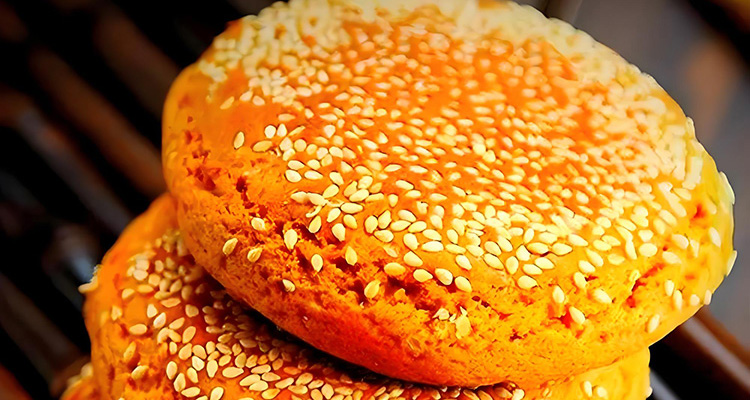Taigu Cake: Shanxi’s Sweet Historic Treat
In the culinary map of Shanxi, Taigu cake stands out as a century-old sweet that combines simple northern ingredients with deep cultural meaning. Loved across China and increasingly popular with visitors to Pingyao ancient city and Taigu County, this honey-sesame pastry tells the story of Jin merchant culture through flavor.
1. Origin and History: A Food Born from Jin Merchant Needs
Taigu cake originated in Taigu County in Shanxi during the late Ming and early Qing eras, when Jin merchants traveled long trade routes. They needed durable, portable food that provided quick energy. Local bakers adapted oil pastry techniques and began baking—rather than frying—dough enriched with honey, creating the Taigu cake beloved ever since. The pastry gained national fame in the Qing dynasty and was reportedly praised by Empress Dowager Cixi during her travels.
2. Cultural Significance: Sweetness with a Story
The cake’s golden color symbolizes the prosperity of Shanxi’s merchant era, while its long shelf life reflects the merchants’ values of honesty and perseverance. In local customs, Taigu cake is a favored festival gift, symbolizing reunion and sweetness. Museums often display Taigu cakes alongside merchant ledgers and packing crates, calling it an “edible relic” of the Tea Road and Jin merchant culture.
3. Ingredients: Simple, Local, Genuine
Taigu cake relies on a short list of high-quality ingredients that showcase Shanxi terroir:
- Hard red wheat flour from the Jinzhong plains
- Natural honey (jujube or blossom honey) from the Lüliang hills
- Cold-pressed sesame (hu ma) oil for nutty aroma
- Farm eggs for a golden, fluffy crumb
- White sugar and toasted sesame seeds for sweetness and texture
No artificial additives—just authentic northern flavors.
4. Making Taigu Cake: Traditional Baking Technique
Traditional artisans still follow age-old methods, often described as “three kneads, three rests”:
- Mix flour with sesame oil, honey and syrup into an enriched dough and let it rest
- Knead and shape into round cakes, sprinkle with peeled white sesame
- Bake in a hanging brick oven with controlled fire: high heat to seal moisture, then slow-bake until uniformly golden
Modern bakeries may use electric ovens but replicate the hanging-oven heat pattern to achieve the classic crisp exterior and tender interior.
5. Flavor and Texture: East Asian Pastry Wisdom
Taigu cake surprises many Western visitors. The first bite reveals toasted sesame and a slightly crisp crust; the interior is unexpectedly soft—somewhere between bread and cake. Sesame oil and honey create a mellow, lingering sweetness that’s never cloying. Even after days, the cake maintains a pleasant softness, a hallmark of its traditional technique.
6. How to Eat It: Traditional and Creative Pairings
Local pairings:
- Breakfast with millet porridge for an authentic Shanxi morning
- Afternoon with a pot of dark fermented tea (fu cha) to balance sweetness
Creative ideas: - Warm briefly and serve with yogurt or ice cream
- Crumble into fruit salads or use as a crunchy topping
Try heating the cake gently to release sesame oil aromas; pairing with aged Shanxi vinegar makes an intriguing sweet-and-sour contrast.
7. Tasting Tips: Enjoy Like a Jin Merchant
- Best eaten fresh from the oven; if packaged, warm for 2–3 minutes
- Look for even golden color and a nutty honey scent
- Taste sequence: observe color, smell sesame-honey aroma, then note the crisp exterior and soft interior
8. Where to Buy and Travel Tips
Authentic sellers include longtime shops in Taigu County and Taigu brands with outlets in Taiyuan Airport and Pingyao ancient city. Price ranges: single traditional cakes about RMB 5–8; premium gift boxes RMB 50–120. Shelf life typically 45–90 days, making Taigu cake a popular edible souvenir. Suggested itinerary: Taigu County (Taigu Cake Museum) + Pingyao ancient city + Qiao Family Compound for a one-day cultural-food route.
9. Simple Home Version: Try It Yourself
A quick home recipe:
Ingredients: 200g all-purpose flour, 40g honey, 30g sesame oil, 20g sugar, 1 egg, 2g baking powder, white sesame
Steps:
- Mix oil, honey, sugar, and egg; add flour and baking powder, knead into a dough and rest 30 minutes
- Shape into small rounds, brush lightly with water and press sesame
- Bake at 180°C for about 20 minutes until golden
It won’t fully mimic the oven-aged depth of the original, but it brings the aroma of the Jinzhong plains to your kitchen.
Conclusion and Call to Taste
Taigu cake may lack the flamboyance of Western desserts, but its understated sweetness and historical depth embody a practical, honest culinary philosophy. On your next Shanxi trip, let your taste buds guide you: in a Pingyao dusk, share a piece of Taigu cake with tea and taste the Jin merchant story baked into every bite.


